[ 1-19 ]|[ 20-39 ]|[ 40-59 ]|[ 60-79 ]|[ 80-100 ]
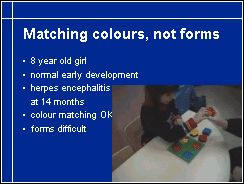
This girl had herpes simplex encephalitis, infection of the brain, at the age of 14 months and nearly died. After long coma she did not move and was blind. However, after several months she started to develop and functions in many ways quite well but at the age of 8 years she had not learned the first letter of her own name even if she seems to see quite well. She came to my office with her neuropsychologist who is performing the test soon after they arrived. The girl sees the LEA Puzzle for the first time. There is no difficulty in matching the colours but when the puzzle board is turned, she cannot match the black-and-white forms with their cut-outs. (This video is on the CD LH Materials 2001, Children with brain damage: Jenny's cognitive vision, Sequence 1.)
The LEA Puzzle was designed to help children to develop the concept "similar/same" first in terms of colours, then with black-and-white forms. It can also be used as a neuropsychologic test as in this case to demonstrate that a child has the ability to match colours but has major difficulties in recognising similarities of black-and-white forms. The internet version can be used to test the different variants of this difficulty.

In the primary visual cortex and in associative visual cortical areas there are cell groups that are best activated by a certain orientation of lines within their receptive field. Other orientations of lines cause less activity. By combining information from a number of cells groups we apparently become aware of orientations of lines in the image.

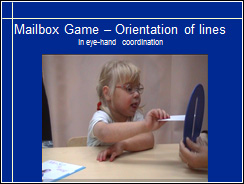
Perception of orientation of lines is examined in two ways: first the child is asked to drop the card through the slot of the 'mailbox'. This is a test situation that most children like.
If the child does not perceive the orientation of the slot and that of the card, the card hits the test surface in the orientation where it was given to the child.

Second test situation is showing with a pen or other narrow object the orientation of the slot without dropping it through the slot.
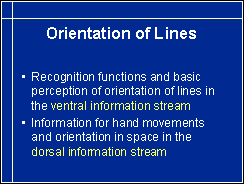
The first task tests eye-hand-coordination, a function of the parietal lobe. This flow of visual information is called the dorsal stream.
The second task tests visual perception of the orientation of the slot as a part of an image, a function in the inferotemporal lobe. This flow of visual information is called the ventral stream.
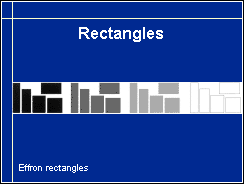
The next test is a modification of Efron's rectangles. They are designed as a play thing to observe and test whether the child can perceive the length of the rectangles correctly. There are more rectangles than in the original version so the test looks like building blocks.

Children less than three years of age can usually tell which of the two rectangles is the longer one. If this is difficult, the rectangles are studied using haptic and kinaesthetic information. If the child can feel which rectangle is longer, then he has the concept of longer. If he still cannot visually discern which rectangle is longer, he has a specific loss of visual functioning, not of understanding.

The related parietal function can be observed when the child organises the rectangles. If the distance between fingers matches the length of the rectangle to be grasped before the fingers touch the rectangle, there is visual information for the grasping function. This slide shows one way of arranging the rectangles.
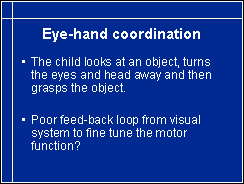
Now and then we observe a child who looks at objects, turns eyes and/or head away and first then grasps the objects. There are several possible explanations. The role of the visual feed-back loop can be assessed at school. Ask the child to grasp several objects one by one varying the task: first ask the child to grasp the object as he usually does, then ask him to grasp the next object while fixating his gaze on the object and thirdly, while holding the head posture toward the object but closing the eyes when reaching for the object. If the movement of the hand is smoother when he is NOT looking at the hand approaching the object, then there is apparently something wrong with the visual information during the movement of the hand. Normally visual feed-back during a movement makes the movement exact. If preventing this function makes he movement more exact, the feed-back function is defective. The child may learn to improve visual feed-back but it may as often remain unchanged.
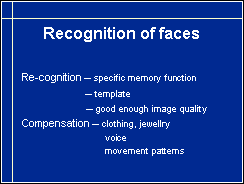
Among the recognition functions, recognition of faces is one of the most important in communication and social skills. It involves several specific recognitions, recognition from profile, recognition from front and back and in different oblique angles. It requires memory functions and good enough form perception. Both functions need to be tested.
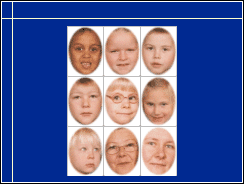
As an example I would like to show what we did in the assessment of a girl who does not recognise her own mother and no other people. We made three sets of these cards with faces of her classmates, herself and her teachers.
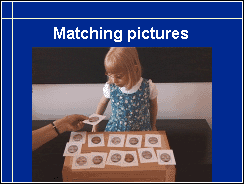
When she was asked to find the pairs, this was no problem, the pictures were seen and matched.
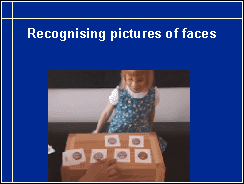
Next she was asked, who the children in the pictures might be. She did not know. She was helped by saying that these children were from her school. That did not help. Then she was told that they were children from her own group. She recognised herself because she is the only one with glasses.
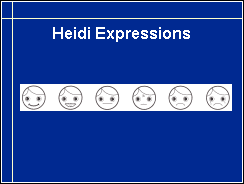
Perception of expressions is an important function like recognition of facial features. To study this function there are the Heidi Expressions cards with six basic expressiosn at three contrast levels.
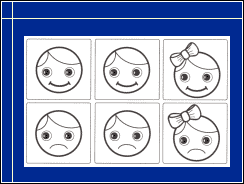
There are two cards exactly alike, in a third card Heidi has a bow. If the child matches all pictures with bow as the same, we point to the mouth of the drawing and discuss the expression without hurry.
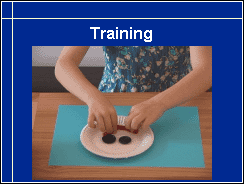
Seeing expressions can be trained by using paper plates to depict the face, dark buttons for eyes and pipe cleaners to make the mouth with different expressions.
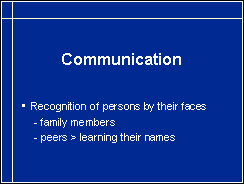
A child's ability to perceive and 'analyse' expressions needs to be observed in many situations: real life play situations, during structured play, in videos and in photographs. If after training with these test play situations the child does not "know" what different expressions mean, the child needs to have an adult who functions as an intervener in a small group of children explaining what is going on and how children respond.
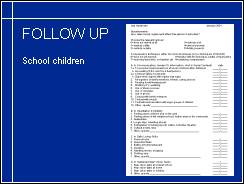
A follow-up document is important in helping the classroom teacher and the local special teacher to remember to assess all areas of visual functioning. Communication and ADL are often forgotten as special subjects in integrated teaching. Integration and inclusion require better teaching of these subjects so that visually impaired children can participate in the activities of their peers.
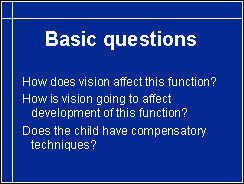
These three questions should be asked frequently: how does vision affect this function or activity? How is it going to affect development of this function or activity? Does the child have compensatory techniques to function in areas where vision based techniques fail? If not, who is going to teach, help the child to learn, those techniques? The more multi-impaired the child is, the more important it is that visual functions are carefully assessed by the local team and the classroom teacher as an integral part of teaching.
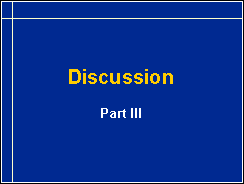

This information needs to be collected before the child is going to school:
- Does the child have anterior visual impairment, posterior visual impairment or a combination of these two impairments?
- Motor functions:
- fixation, is it stable, too short or not present, central or eccentric; nystagmus with/without null position?
- are the saccadic movements accurate; compensated with head movements?
- how regular are the tracking movements; compensated with head movements?
- are there any involuntary eye movements during spasms or epileptic activity?
- Sensory functions:
- visual acuity, all 4-5 measures with optotypes; smallest and optimal text size
- contrast sensitivity, at least visual acuity at 2.5% contrast
- colour vision, confusion areas, which colours need to be avoided
- visual field for orientation and for reading
- visual adaptation, speed of adaptation, any effect on walking to school in twilight; can the child go out during breaks on sunny days when using his absorptive lenses?
- does the child recognise people by their facial features, if not which compensatory techniques have been used for recognition?
- does the child see expressions?
- motion perception; does the child see objects that stand still as well as those moving?
- does the child perceive size, length or does (s)he need haptic confirmation?
- does the child see directions of lines?
- does the child see details in pictures with many details?
- can the child play with age appropriate puzzles?
- eye-hand coordination, use of pencil and pen, drawing
- Vision for orientation and mobility, what needs to be considered in physical training?
- What kind of vision the child has for sustained near work? Glasses, devices. Motivation and skills to use them; new devices to be considered during the term?
- Illumination at the desk (and the black board), in the classroom and the corridors.
- Which devices should the school purchase, which come from other sources?
- Does the child have symmetric, normal hearing? Any other functional difficulties, disorders or diseases that might affect functioning at school?
- Prognosis: stable or progressive condition.